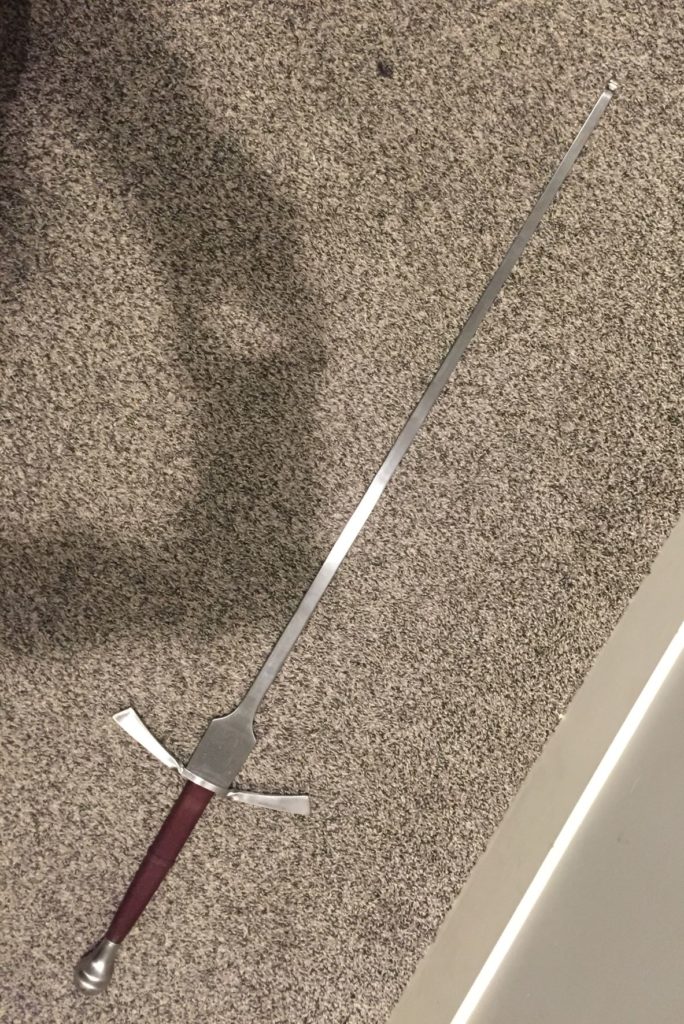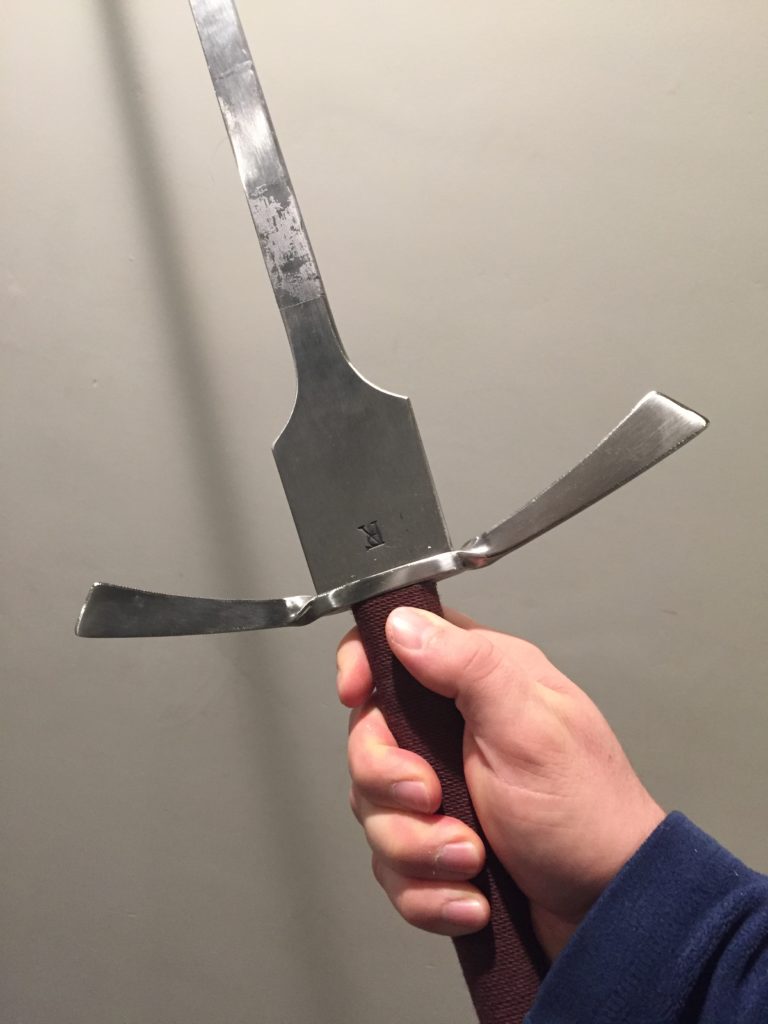Yesterday I got my new Regenyei training swords in. Somehow the word feder has become modern parlance for these weapons, but that was not quite what they called their training weapons back in the day. So I won’t refer to them as feders. If you want more info on that please check out The Whatchamacallit Sword on HROARR. Anyhow, I am extremely pleased with these training swords and I would like to gush about how fantastic they are for just a little while.

First, while it hasn’t yet become fashionable to make perfectly historically accurate training swords, there are several reasons to depart from the historical precedent, not the least of which are modern tournament restrictions, but that’s a can of worms to open another day. These swords qualify for all of the major tournaments in my part of the world. Secondly, and from my perspective, much more importantly, these training swords fall within the common range of size, dimensions, and proportions for period bastard swords. Not only is this badly underrepresented in the market, but they also serve as a more convenient size for people who simply aren’t tall enough to be able to easily employ a much larger sword. Most of the modern training swords have lengths between 49″-53″ (125-135 cm). SIGI’s Shorty model is 49″.
While we do see historical longsword 53″ (135 cm) long, those are outliers in the period we’re looking at. Moreover, if you’re a 5’4″ student, and I have two young women about that height in my class, and two young men just a little taller, a longsword that goes past your shoulder ceases to be a longsword. You cease to be able to do longsword technique with a weapon that size. Most historical longswords from the late 1300s to the early 1500s, which is the period where most of our longsword texts come form are closer to 44″-48″ (112-122 cm). These Regenyei’s are 46″ (117 cm) in overall length, which is average for period swords, but substantially shorter than the modern average. So not only do I now have a great set of training swords to represent period bastard swords, but I have a pair of weapons that are very well suited to shorter people. Both their technique and their performance show marked improvements from getting these swords.
Anyhow I should tell you which features I chose; 90 cm blade (shortest they have), 26 cm handle (shortest they have), curved and twisted crossguard (I like the way curved crossguards work), the schilt from the Regenyei short model rather than their standard or schiltless designs. I had them add a riser 4″ from the guard so that your pinky or ring finger can sit under it and keep your hand from riding up too close to the hilt, and I chose their pear pommel to finish it off.
When I initially approached the company about making these I requested a forward pivot point within an inch or so of the point. I was informed that this was beyond the scope of the kind of work they were willing to do, so I took a step back did some thinking about how best to get the training sword I wanted. I decided I wanted a more substantial schilt and pommel with more back weighting to maximize the likelihood that the weapons would turn out right. Most of their pommels would work fine for this, their pear, perfume, mushroom, and scent stopper should all perform similarly in this regard.
Much more importantly, I wasn’t particularly happy with the standard schilt options. I did not want a schilt that would offer an unrealistic level of hand protection, or which would bind in unrealistic ways. All of the standard models of schilt in the Custom Feder page catch and hold a blade a couple of inches from the cross, or in unrealistic ways. While historically accurate to some training swords, this is not a feature I want, because I choose to emphasize realism, and I’ve never seen a real sword from the period with such a feature. You can’t learn to protect your hands correctly if your training sword does it for you, and with features like that so close to the cross your close range slicing actions would be inhibited on a real blade. The binds would also be different because your weapon won’t actually be bound on the cross.
The schiltless model was tempting, but I wasn’t sure that it would have the right weight distribution, and I once had a training sword disallowed at a tournament, ostensibly because it didn’t have a schilt. Looking through Mr. Regenyei’s other offerings though I found that his Short model actually had a schilt that might fit both of my requirements. It has a curve toward the blade that will allow a sword to come all the way to your cross, but a substantial width to add weight at that point. His “short” model, however, has a 38″ (96 cm) blade and a 11.5″ (29 cm) handle for an overall length of 49.5″ (125 cm), which is just plain too big for what I needed. Thankfully, they were willing to use their short model’s schilt on these training swords.

Forgive me for not cleaning the tape residue off before taking the picture. I was excited.
On to how they perform. These things feel great. When one of my target students picked it up her first question was “Where do I get one of these?” That forward pivot point I wanted, but that they declined to promise, is exactly where I wanted it on both swords. The fact that it’s there on both swords probably means that they tried to deliver on it hoping to exceed my expectations. It could possibly mean that I just hit upon a particularly good combination of features, and that their standardization is so good that anyone who picked this combination would get a similar result, but until I hear otherwise I’m inclined to give them the benefit of the doubt. It’s point is super accurate, and combined with the short length it not only becomes substantially easier to nail someone with a thrust, but it becomes darn near impossible for someone to get inside your minimum thrusting distance without forcing them to close to grappling distance, which is a great advantage when fighting against sword and buckler, or for pressing an advantage into close distance against a big longsword. For an in-fighter like me this is a fantastic training sword.
The blades are nice and stiff, with just enough flex to be durable and cushion a thrust a little. The cord grip is tight and quite comfortable. Hopefully it will hold up for years. On reflection I wish I had ordered the faceted scent stopper pommel, to give a little more control to the left hand, but I’m willing to let the smooth pear pommel have its chance, maybe I’ll learn to love it. If there is an actual flaw in the weapon, I’d say that I’d like it to be just a little heavier. Don’t get me wrong it’s around 2.3-2.5 lbs (1000-1130 grams), within historical parameters, but just barely. It is designed to model a lighter more nimble longsword design. If I had to choose between it’s frankly perfect balance, and a little more weight, I’d keep it the way it is though.
My final conclusion, Mr. Regenyei’s service exceeded every expectation he set. He was accommodating and forthright. The weapons look beautiful, arrived in perfect condition, handle like a dream, are the right size for historical purposes, work beautifully for when I want to simulate a bastard sword, and are perfect for my shorter students. I strongly recommend getting one of these from Mr. Regenyei if you want a a sword that better fits historical parameters for bastard swords or if you find the common offerings on the market just too big for you. In other words every serious HEMA club that practices longsword from the 1300s-1500s should get a training sword like this.